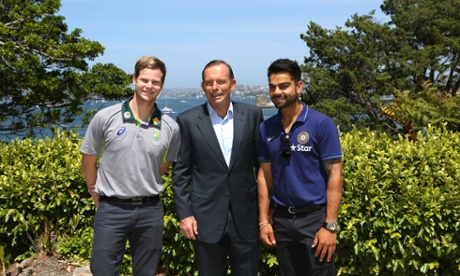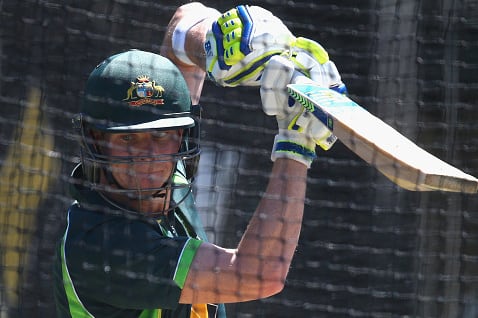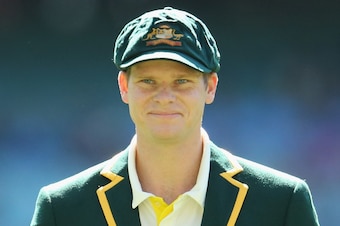Virat Kohli in Australia: Look for fights. Smell arguments. Create arguments. Be prepared to cop it'Kohli should bring his own qualities to captaincy'
"Virat is, of course, doing his first Test match now. If he gonna do or not, I don't know about that. He's a different captain than Dhoni bhai. He's more charged up, more aggressive."
Pause. Oops. What am I saying?
"Of course they both are aggressive in a different way. I enjoy playing under both."
You can only wonder what Shikhar Dhawan wanted to say before he stopped himself during this press interview before the start of the series. You can be sure, though, that he didn't know MS Dhoni would quit mid-series. Even when asked to compare the styles of
Virat Kohli and Dhoni, Dhawan wasn't sure Kohli would actually captain in the first Test, as he was expected to. Phillip Hughes' death had rescheduled the first Test, giving Dhoni time to arrive before the start of the series. But would Dhoni be fit enough? The Indian team wouldn't say. You could only hope, for their sake, that Kohli and Dhoni knew.
You knew, though, that Kohli would lead the team differently. Dhawan knew it too. And why should two men be the same? What was this difference going to be, though? Was he going to lead the side in the first place?
"I don't mind a fight. I don't mind a chat on the field, a bit of banter. It probably makes me more determined, I guess. It's not that only that makes me determined… Last time around I enjoyed it. I found it hard to take it for a couple of Tests, but after a couple of incidents I found out there's no other way of playing in Australia. Rather just be myself."
At a press conference a day before the Adelaide Test, Kohli conveyed he was not only going to lead India in Adelaide, he was going to be emphatic about it. He was going to make statements, something Dhoni didn't.
Kohli was going to bounce Australia - "not even a thing of debate" - even though he spoke fondly of Phillip Hughes, with whom he had camped in Brisbane as a youngster. He didn't say it, but Kohli was going to pick uncapped legspinner Karn Sharma over tried-and-tested R Ashwin. He was not going to keep doing the same thing and expect different results. He was not going to consider the runs the bowler might score when making a choice.
Dhoni was always more pragmatic. He wouldn't say things that would bring pressure of expectation. He wanted the lower order to score runs too. He wouldn't have promised bouncers. He would have said, "Wait and watch." Right then, we were waiting and watching for Kohli.
"That was my personal decision. We felt that Karn was bowling better than the other two spinners at the time. In the warm-up games and the practice sessions as well… It was my personal decision. No regrets."
Karn went for 238 runs in 49 overs for four wickets, all of which came from batsmen trying to score fast, having seen no threat in the bowling. On a pitch where Nathan Lyon took 12. Playing a legspinner was a noble idea, but was Karn, picked on the basis of Twenty20 performances, the right man? An aggressive captain is a noble thought, quite amorphous, but was Kohli - three first-class matches as captain before Adelaide - the right man? The bowling plans were poor, runs were not kept in check, aggression showed more in what was said than done, and people with crooked backs scored hundreds against them. But for rain, and injury and illness in the Australia camp, there wouldn't have been a generous declaration in the first innings. India would have been thrashed.
Dhoni would have used the word "we". Dhoni made personal decisions only on the field. Off the field, it was always "we". Kohli was being more assertive off the field, even in defeat.
"You're all right?"
Or words to that effect. From almost every Australian on the field. Kohli had been sconed first ball he faced in the series. Mitchell Johnson, the bowler, looked concerned, too. These were different times. A man had died in Australia after being hit by a bouncer. It was not the same anymore. Johnson wasn't the same anymore. No sledging, no stares, no more bouncers. You wonder how different this series would have been for Kohli if the visiting captain had got the treatment you get in Australia when you wear one on the head first thing you walk out into the middle.
That's not Kohli's issue, though. For his part he waved everyone away. Even help from his own dressing room. Didn't even change the helmet. Didn't take a backward step. Became only the second man to score twin hundreds on captaincy debut. He was going to lead with the bat. He was going to lead with the mouth. Australia were subdued, but he would get in their face. Give them send-offs even if the scoreboard read 1 for 200. Look for fights. Smell arguments. Create arguments. Not worry about how it will affect him when he bats. Be prepared to cop it. Just rattle off another century in a tense chase.
The whole of Australia stood up for Kohli when he finally fell for 141 off 175. In the pub, bearded men from the country began to say, "That's our kind of player." Their demands of "our kind of player" have come down from mustachioed men with an unruly mop, long-collared shirts buttoned down and a cigarette in hand. All they want now is someone who shows he cares, who shows he is bringing the fight to them, and who can back it all up with runs or with wickets. Not that Dhoni didn't, but he was mostly subtle. Sometimes too subtle
They were calling me a spoilt brat, and I said, 'Maybe that's the way I am. You guys hate me, and I like that.' I don't mind having a chat on the field, and it worked in my favour I guess. I like playing against Australia because it is very hard for them to stay calm. I don't mind an argument on the field, and it really excites me, and brings the best out of me. So they don't seem to be learning the lesson."
Australia actually learnt their lesson in Melbourne. They haven't been bowling well to Kohli. He hasn't got out in the series defending the ball, playing that push outside off that was lethal in England, getting him five times out of 10. England had some seam movement. Old Trafford and The Oval had extra bounce, too. Trying to drag him wide hasn't worked for three reasons. Kohli has pushed his guard closer to off stump, and he is standing a foot outside the crease, even to Johnson. The pitches haven't provided enough lateral movement. Also the openers have been giving India some sort of platform, which means he is not walking out - as he did in England - at 2 for 20. So Australia have been trying to bounce Kohli: he has scored 66 runs off 38 pulls.
In Melbourne's first innings, though, Australia persisted with the plan of getting him out outside off. They fed neither the on-drive/flick nor the pull. Only one out of the first 20 and five of the first 28 runs from Kohli came on the leg side. The bowling remained outside off, but Kohli kept covering the line. This was a fascinating spell of play. Kohli was getting no easy runs, but he was equal to the task. He had to take risks to keep the runs coming, but he was aided to an extent by the flatness of the pitch. Yet he was racing away to what only one Indian has ever done before, that too against a Packer-depleted Australia: score three centuries in one series in Australia.
"I was really annoyed with him hitting me with the ball. I told him that's not on. 'Try and hit the stumps next time, not my body.' You have got to send the right message across. I am not there to take some unnecessary words or chats from someone. I am going there to play cricket, back myself. There's no good reason that I should unnecessarily respect some people when they are not."
Earlier in the match, Mohammed Shami fielded the ball in his follow-through, and threw it back at Steven Smith, even though the batsman was well back in his crease. Shami then smiled at Smith for a few seconds before raising his hand in token apology.
When Johnson hit Kohli, the batsman was trying to get back to the crease after having taken a step down the wicket. He was in line with the stumps. Smith didn't react much, but Kohli just let rip. Later in the day, Ryan Harris said he had no idea where Kohli got the 'they-don't-respect-me' notion from. "I respect him, and I know all the boys in the change room respect him because he has come out and his bat does the talking."
Surely this is not about respect? Kohli likes to believe he does well when he is fired up, angry. A bit like James Anderson, who is believed to be known to at his best when he is Jimmy, the nasty avatar. Kohli is possibly looking for things to fire himself up. Or he is trying to unsettle the bowlers. There is a deliberateness to the way he talks in a press conference. He is too shrewd to actually get affected by lack of respect from Johnson or Harris.
"You always have a few who can't keep calm in every team. So I have my targets."
Kohli believes he needs someone to spar with to get the best out of him. But does it? He was on 84 in the first innings of Melbourne when Johnson's throw hit him. He got into an altercation. The next ball he faced he drove loosely, and just about managed to not edge it. This was unlike how he had played. This was a get-out-of-my-face shot. Bowlers love it when a verbal gets the batsmen to do such things. Johnson would have smiled at that attempt. Three balls later he drove loosely again, and got away with a thick edge. He edged the next ball he faced from Johnson, and was dropped. So in three balls out of the five just after the altercation, Kohli could have got out. Agonisingly close to a hundred.
"Hey, thanks for the 170. I'm playing superbly, don't you think?"
Or words to that effect. Apparently Kohli has been saying similar things to the Australians. There hasn't been much abuse. This has been infuriating Australia. They can't do much about it by the way of reporting it to the officials. Known as Cheeku in his younger years, Kohli is cheekily goading the Australians. He is trying to be a nuisance. He is trying to be everything they don't want him to be. In a way he might be a bit like they are. Maybe more than a bit. Maybe that's why the tussle?
"It's all about you."
"There he goes, after his own mate."
Brad Haddin, standing halfway between his mark and the stumps, was heard saying this to Kohli, his hands clapping as if to encourage his own team. This was just after Kohli had almost run himself out in the second innings, when trying to save the Test. Haddin got to him again. During the next four balls Kohli got an edge that fell short of gully twice, hit one uppishly back at Nathan Lyon and one just wide of short leg, and pushed softly at a wide one, the best result out of which can only be a dot and the worst - and more frequent one - edge to slips.
Kohli has been walking around with a bull's eye around his head. One he has worn proudly. Everything about him has said, "Look at me." His statements, his shots, his send-offs, his fielding, his kisses blown to his Bollywood-star girlfriend and to Mitchell Johnson. He has riled the Australians up, he has nearly got out because of that wind-up job, he has dropped a sitter at slip, he is about to become the first No. 4 in the history of the game to score 500 in a series when touring Australia, and he has generally looked and behaved like a man whose time has come.
It was not so in England. There he looked distracted, bothered by coverage of his girlfriend's presence with him in England, unsure of his feet and of his mind. Not much has changed on the field since. He has made technical changes, but he hasn't scored many runs between the two Test series. Something has just clicked. The swagger has been more pronounced than ever before.
Now he will captain India. Now he will have to set fields for bowlers who keep on bowling one on the pads every over. Now he will have to deal with off-the-field matters, a sample of which he has already got through the reporting and analyses of Dhoni's retirement. Now he will have to set defensive fields once the opposition gets away, which the opposition usually does when India bowl away from home. In many ways this series has belonged to Kohli, but in many still - as Darren Lehmann said with regards to sledging Kohli - "We haven't even started yet."













 '
'









